Bubbles, Balloons and Blooms: April Q&A
Today, we’re taking a step back from talking about coronavirus, to bring you a QnA show with a difference! We’re answering some of the questions you’ve been sending in, and we’re also getting stuck in to some kitchen science experiments which you can join in with at home, whether you're a big kid or a little one.
In this episode
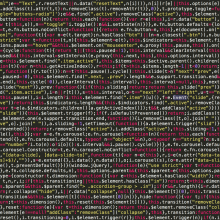
01:03 - Storing data indefinitely
Storing data indefinitely
Professor Colin Johnson, Nottingham University
Our first listener question came in from Paul, who asked "What's the best way to store information, for perpetuity?". Computer science expert Colin Johnson from Nottingham University pondered this one for us...
Colin - It’s difficult to store information so that it can be accessed dozens, hundreds, or thousands of years into the future. I’m sure we’ve all found a piece of paper that has faded after years in the sun, or tried to play an old VHS tape, or found a vinyl record but haven’t got a record player. Even if we etch words into stone, centuries of erosion will render them illegible.
Already, a lot of VHS tapes are unwatchable. CDs and DVDs – once touted as indestructible – might not last our lifetimes. Even if the physical media survive, the machines might not. Some early video games cannot be played any more because the consoles no longer work. Whole media, such as the teletext service that provided text on TVs, are almost lost to history - though there has been some recent success in recovering it from old video tapes.
What about a technology that doesn’t require any hardware, like a printed book? Many books from the nineteenth and twentieth centuries were printed on slightly acidic paper that broke down over many decades, and so since the 1950s books have been printed on acid-free paper that should last 500-1000 years.
But, improving the media that we store information on will only take us so far. If we want to preserve information for the long run, we need to make fresh copies of the information regularly. This is how texts have survived from the ancient world. Physical copies of the works of Ancient Greek playwrights and philosophers haven’t survived to the present day, but their words have been copied and re-copied over the centuries.
This applies to information stored on computers too. Rather than trying to make a disk last forever, instead we can copy it onto a new disk every few years – and don’t encode it in a way that relies on a specific piece of software to play it back.
This gets harder in an era when information is distributed across the Internet. One document might survive, but its links to other documents don’t. In 2017 the Canadian Supreme Court realised that many of its recent judgements referred to information on websites that had since vanished, and so now a copy of the sites are archived along with the judgement.
What about really long-term storage of information? What if we need to store information that might outlive the English language, or the collapse of civilisation? This is a challenge for scientists who are storing nuclear waste that will be around for millennia. Rather than relying on text, or any kind of culturally-specific image (such as a warning triangle), instead they have to think about the fundamentals of how we communicate ideas, resorting to basic pictograms and thinking about how a civilisation thousands of years hence might interpret – or misinterpret – that message.
So, it depends on how long you want to store it for. To ensure that your grandchildren can read it, a good quality printed book is fine. If you want it to last for millennia, you have a different challenge on your hands!
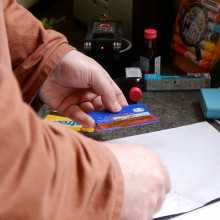
Loyalty card code
Dave Ansell, Sciansell; Adam Murphy
For our first kitchen science demo of the show, Dave Ansell and Adam Murphy get to work with a rusty object, a loyalty card, and some sandpaper...
Dave Ansell - What you want to do first is get your rusty object and your sand paper and have something to catch the dust which comes off it cause that's what we're interested in and sand some of your rusty object onto your cup or your piece of paper to catch it with. So I've got an old barbecue, a very small round barbecue thing, which is very, very rusty cause it's been sitting in my garden for yonks, and just a piece of sand paper, which I picked out of the shed and I'm just sanding to produce a nice fine dust basically.
Adam - Well I've got an iron pot lid. It's got a bit of rust on the rim. I've got an old Emery board nail file because I couldn't find any sandpaper and a little plastic cup to catch it in. So now I have my plastic cup in front of me and it is full of a reddy-orange powder, which is the powdered rust. What do I do with it now Dave?
Dave Ansell - Put it onto the magnetic strip of your card very liberally and just kind of cover the basic strip with the rust powder. Ideally you want the finer rather than the really coarse powder and just spread it on so the whole of that strip is covered.
Adam - Okay, so I've got the card and I've got the cup full of the rust powder and I'm just going to start tapping it out gently. So I don't cover the entire house in rust.
Dave Ansell - And then once you've got it covered, just sort of gently tap the card. So the rust falls off.
Adam - Okay, so I've got something on this.
Dave Ansell - What can you see?
Adam - And what I've got is that the rust particles have formed kind of in stripes like you get on the back of a barcode packaging, like just loads of little stripes where there's rust and stripes where there's not.
Dave Ansell - That's brilliant. It turns out, it doesn't work in with every card. So you may have to try two or three until you get one which works.
Adam - Yeah, this is the newest one I have.
Dave Ansell - Yeah, they do tend to die after a while. Adam's one is working better than mine. I can see some stripes but it's uh, only in one corner of my card. But there are definitely some stripes on there. So what you're seeing is the magnetic strip is, as the name would imply, is magnetic and it stores information by having strips which are magnetic one way and magnetic the other way, and other bits, which aren't magnetic at all. What you're seeing is that the magnetic rust particles are only sticking to the parts which are magnetic. So you can visualize that magnetic barcode with your eyes
Adam - And then how would a card reader read any information off of that barcode type thing then?
Dave Ansell - If you move a magnet near a coil of wire, you basically create a little tiny generator and you generate a voltage in that coil of wire. So there's a coil of wire in the magnetic barcode reader and as you pull the strip past it it induces little tiny voltages in that coil of wire, which are electronics the computer can read as I think what's normally stored on there is a number on the front of the card.
Adam - And then is this the best way to store information or is it just a good way to store information? What is the best way?
Dave Ansell - It depends what you mean by best. It's quite a retro way of storing information. It's the same technology as cassette tapes to the older members of the audience or VHS video tapes all use the same kind of magnetic storage of data which are now having issues because after 30 40 years, the tape starts to degrade and the rust falls off the tape. And so it stops being able to store information and suddenly all those radio shows which everyone loved in the 70s becoming very hard to recover because even though the tape exists, the information has fallen off it, it's just a pile of rust at the bottom of the cap.
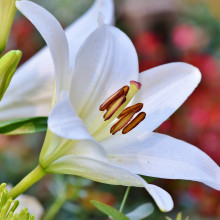
10:07 - Blooming bunches
Blooming bunches
Alice Fairnie, Cambridge University
Julie wanted to know how lilies can flower when they've been cut away from their roots, and placed in a vase. Plant scientist Alice Fairnie from Cambridge University's Sainsbury Laboratory got on the case...
Alice Fairnie - Flowers - they're the reproductive structures of a plant and they open for pollination and to produce seeds. Most flowers won't produce seeds and that's because they lack the energy that comes from their now detached roots. But cut flowers, do open. The answer to the incredible act of blooming is in the mechanisms of flower opening.
Katie - and we'll come onto those mechanisms shortly, but there are already a few clues in Julie's question. The lilies are in a vase of water and the bouquet was accompanied by what she referred to as the little salt sachet or packet. Alice says that for most flower species, opening and movement depends primarily on cell growth, elongation and expansion. And it's influenced by internal as well as external environments. Petal cell growth, elongation and expansion in turn depend on inputs, mainly water and heat. Remember Julie's vase was filled with water. Well, how about trying an experiment at home, split your cut flowers between vases with and without water and with and without the sun. Does this change how they open?
Alice Fairnie - You might also notice differences between flower species and their response to the different experimental conditions. This is because although cell expansion and growth can explain much of flower opening, there are internal and external influences that also influence opening and that vary between flowers. Different flowers for example, have different flower forms and the cell in different petal regions - for example, front versus back, the centre or the middle versus the edge - might expand at different rates and this will create different patterns of uncurling and opening. Different flowers are also found in different environments. Julie has lilies and I have tulips on my desk. I also work with a hibiscus.
Katie - Lilies, Alice explains, remain open after blooming. Tulips repeatedly open and close with fluctuations in their external environment, and the hibiscus flower that Alice works with is affectionately and perhaps aptly named flower of an hour because each flower opens only in the right environmental conditions and only for a day or sometimes an hour.
Alice Fairnie - But interestingly they do open when the flower has been cut and when that flower that is cut is without water. And this is because they're adapted to their environment in which they experience water shortages. Cotton stems, which are relatives of hibiscus, share the ability to open their flowers when they've been cut and without water. And this is because they are resistant to stem blockages. These stem blockages prevent water from reaching their flowers. They also store water in their cells if their flowers too, which means they can open even when the stem is without water. Cut roses, on the other hand, constantly need trimming to prevent water blockages and to let the water flow to their flower cells. Rose food, for example, will often include stem unpluggers - chemicals that stop the stem from blocking and ensure your flowers open. And this brings me to those little salt packages you mentioned. These packages do look like salt, but they're in fact plant food. A mixture typically of sugar and bleach, but sometimes these stem unpluggers. Why don't the packages contain salt? While salt is dehydrating, if we have salt in our vase or in our water, we draw water away from the cells and the stem and prevent flower cells from expanding.
Katie - So why is sugar in these packets? Well, sugar is a food for plants to promote cell expansion and growth. Just like the sugars and energy needed to fuel legs through a marathon, or my legs, a light jog. To increase the life of your cut lilies, Alice suggests, Julie, that you try removing a few of the dying flowers from a still blooming bud. This will help new buds access the limited sugar supplies rather than feeding the old dying ones. So in the packets of so-called plant food you get with a bunch of flowers there's sugar, chemicals to prevent the stems getting plugged up and bleach.
Alice Fairnie - Why is there bleach? Well bleach also helps with floral longevity by keeping the cut stems clean and preventing bacterial growth. You could experiment at home, add salt or sugar to your vase. Are there other nutrients that plants need to grow? Do they need hormones like us? You can even visualize water movement within the stems, just add a couple of droplets of food coloring to your vase, either with freshly cut flowers, old flowers stems, or stems that have been sealed at the base with vaseline that mimics the stem blocking.
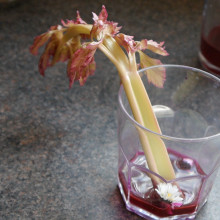
16:26 - Celery and xylem
Celery and xylem
Dave Ansell, Sciansell; Adam Murphy
Dave Ansell shows Adam Murphy how plants get water from their roots to their leaves, using some rather sad celery...
Dave - For this demo, what you want is, ideally, some nice fresh carnations, or something with nice big white petals, which is just coming into bloom and is really enthusiastic. However, it's a bit hard to get hold of at the moment. So what I've got is some slightly ill looking daisies and some very ill looking celery.
Adam - And I didn't want to go off and steal my neighbour's flowers. So all I have is some celery
Dave - And you also want a little bit of water in a cup, or a glass, and something to colour that water with. So either some food colouring or maybe an old felt pen, which isn't really dead, washable felt pens, which can pull the sponge in the back out of, and get the ink out of it. If you are opening up a felt pen, be very careful, especially the ones designed for younger children, are incredibly hard to open. So get an adult to do that.
Adam - Okay, so I've got a jar and I'm going to fill that up with water.
Dave - I'll do the same. And then you want to colour it with food colouring or some ink. So it's fairly dark, not completely opaque. You don't want it with so much ink in there that it's kind of syrupy, but you want it so it's definitely very strongly coloured.
Adam - I'm going to open this bottle of red food colouring that I have. It's a very dark red food colouring and I'm going to just open it up, and then pour in. And now I have a jar of dark red liquid, which looks very suspect.
Dave - I've just taken the sponge out of the back of a child's felt pen, and I'm just squeezing the ink out of it into the water. So I'm getting some really deep purple water. I'm not 100% sure which of these is going to work best, but we can both try one and see which is the best way of colouring water. Okay, so mix in that ink or food colouring. And I now have very purple fingers. So now we want to treat your flowers or the celery as if it was normal cut flowers. So you want to cut them probably diagonally, put them into the water and then leave them for a while.
Adam - Well, I've got my sharp knife. And if you're doing this at home, please remember to have a grownup with you while you do this. And I'm cutting the bottom of my celery. And now I have freshly cut celery and this goes in the jar, Dave? Yes?
Dave - Yeah. So I'm doing the same thing with my slightly ill looking daisies, and my very ill looking celery, put it in the jar as if it was a vase, then you want to put it on a nice bright windowsill, where it's reasonably warm and then we'll come back in a few days and see what happens.
Katie - Which funnily enough, is exactly what they did.
Dave - So it's been three days and I've got various flowers and celery in various different coloured liquids. How have yours done Adam?
Adam - Mine have not gone particularly well. I just have some celery sitting in some red water. It hasn't really done anything. What about your end, Dave? What have you gotten?
Dave - So I've got one, which is basically exactly the same as yours, which is just some celery sitting in some red water. And I've got some daisies sitting in some blue water, which has done virtually nothing. I think both of these were in food colouring. That's what you used wasn't it?
Adam - It was indeed, red food colouring.
Dave - However, the one I used in ink from a felt pen has worked really nicely. The leaves are all nice and purple. It looks like almost a different breed of celery.
Adam - Why has one worked, and one not worked?
Dave - So I think this was a mistake I made, which was that food colouring has changed since I was a child. In the olden days, food colouring was made of all sorts of lovely, very soluble chemicals, made in a chemical factory, which were very strongly coloured. Whereas these days, because those are possibly not ideal for children, they've converted lots of vegetable dyes which have got bigger molecules, and they're probably more likely to stick to organic things, to plants. And so if I slice up my celery, in fact, do you want to try this too Adam? Just take a series of small slices off the bottom of your celery, see if you can see the colour working its way up the celery at all.
Adam - So if I look really closely, there's like one or two red veins working their way, maybe a centimetre or two up to celery. That's about it.
Dave - Yeah, that's what I've found with my celery. If I cut down, after about a centimetre, they stop entirely, on the celery from the food colouring, because what's going on in the plants, is they've got little tiny tubes which go from the roots up the leaves, which are way of solving a problem that plants have, which is how to get all the useful nutrients up from the roots up to the leaves, because they don't have a heart. They have no way of pumping it actively. So what they have, is they have these long thin tubes called xylem, which go from the leaves down to the roots, and whilst the roots do push the water up a little bit, mostly what's happening is that water evaporates from the leaves, and that reduces the pressure in these tubes, and that just basically sucks more water up through these long xylem and water and the nutrients get taken up with it.
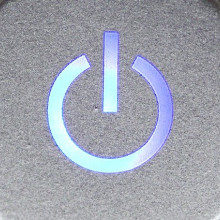
23:26 - What happens to "un-used" electricity?
What happens to "un-used" electricity?
Rachel Lee, Sheffield University
Listener Andrew wants to know what happens to "un-used" electricity. He says:
"I live in Australia and am fairly used to periodic load-shedding when, for instance, the grid can't supply everyone's air-conditioning on very hot days. But what happens when there is very low demand? There is power when you switch a light on, but when it is switched off again, where does that electricity go. It's being generated and fed into the grid, but if everyone switched off their homes at the same time, what would happen to that electricity fed into the wires at the generator end?"
Energy industry specialist and now energy storage PhD researcher Rachel Lee from Sheffield University took this question on for us...
Rachel - In an electricity system like the Australian Grid, electricity generated must be matched on a second-by-second basis to the electricity required by consumers. So when you switch a light on in your house, somewhere in the country a generator puts more fuel in, or a hydro plant takes more water. When you turn it off the opposite happens.
Electricity is generated and transmitted as alternating current or AC, meaning that the it comes to your house as a wave that is constantly cycling from positive to negative and back again. How quickly that happens depends on the speed the generators are turning. In Australia and many parts of the world, we aim to have 50 of those cycles every second; we call that the frequency in Hertz, so that’s the 50Hz you may have heard of.
The operator of the network detects the change in load by a change in that frequency. If demand exceeds supply the generators slow down, just like your car going up a hill, and frequency falls and vice versa. Of course with just a light, the extra electricity required is so small compared to the total supply that it is lost in all the other things being turned on and off. But when the changes in load are large, for example when people get home at 5-6pm and all turn on their air-conditioners, the system frequency will start to fall. Some generators will automatically start increasing output to bring the frequency back to 50Hz, but in some cases the system operator may request additional plant to start.
If there isn’t enough plant available, then that is when load shedding could happen. However, load shedding is often a result of high demands locally in the system when the wires and transformers supplying your area get overloaded.
If everyone switched off at the same time, then the system frequency would rise very rapidly. Plants in automatic frequency control would quickly reduce their output, but if this wasn’t enough then eventually the frequency would go so high that ‘over-frequency’ protection on generators and other parts of the system would operate and disconnect generators completely.
Normally the system frequency is very tightly controlled; in Australia AEMO, The Australian Electricity Market Operator, aims to control the frequency between 49.85 and 50.15Hz. Within this normal range, generators are centrally set to their required output every 5 minutes and further signals are sent to raise or lower output on a second by second basis. If the frequency goes outside of those bounds, then ‘Contingency Frequency Control Services’ are called upon to operate and these aim to maintain the frequency between 49.5Hz and 50.5Hz. Depending on the service provided, these must respond between 6 seconds and 5 minutes.
Although the fine detail of frequency control varies around the world, the basic process remains the same everywhere; a system frequency below normal means more generation is required and a frequency above normal means less generation is required. There is never any spare electricity!
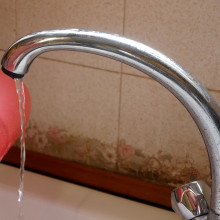
28:21 - Statics and hair standing on end
Statics and hair standing on end
Dave Ansell, Sciansell
For this next demo, you'll need a balloon, a tap, and access to some hair! Dave Ansell took Adam Murphy through this electrifying experiment...
Dave - For this demo, what you're going to need is a balloon, either a long thin one or a short round one and a tap, which you can turn down. And some hair. Many people find their head hair works well. Cat hair is supposed to be brilliant. But I find that the best is my leg hair?
Adam - Okay. So I've got a purple princess balloon because that's what the shop had, I'm standing beside my tap and I needed a haircut two weeks before we went into isolation. So I definitely have enough hair to do this. What do I do with this stuff, Dave?
Dave - First blow up your balloon, I'll blow up mine.
Adam - Okay, I've got my balloon all blown up. Now what do I do with this?
Dave - What I want you to do is rub it on some hair. I'll pull up my trouser leg and rub it on my leg.
Adam - Okay. Just rubbing this on my head hair now. I am in dire need of a haircut. Okay, so I've got a head rubbed balloon. What do I do now, Dave?
Dave - So did you notice anything odd happening as you were rubbing it?
Adam - Yeah, my hair is standing on end now.
Dave - So what's happening is that the electrons, which are little tiny particles which whiz around atoms and are negatively charged, slightly prefer being in the balloon than being in your hair. So whenever a bit of hair touches onto a bit of a balloon, a few electrons get transferred from one to the other. Not many, a very, very small number get transferred. The reason why you're rubbing is because as you rub more different bits of hair get to touch different bits of balloon. So more electrons are transferred, and you get a bigger negative charge transferred to the balloon. Now what I want you to do is turn on your tap, so you've got a very thin but continuous stream of water coming out along it.
Adam - Okay. Turning on my tap now.
Dave - To make sure the balloon is really well charged, give it another quick rub on your hair. And then move the bit of the balloon which you've charged up close to that stream of water.
Adam - Okay, so when I bring the balloon near the water, it starts to pull the stream of water towards it. Like they were magnets coming together.
Dave - Totally. What happened with your hair earlier, is that your balloon was becoming negatively charged, and your hair was becoming positively charged, because it lost its negative charge and positive attracts negative. So your hair was attracted to the balloon. But with the stream of water, the stream of water isn't positively charged, but when you put the balloon near it, it will tend to repel any negative charge, and the electrons then be able to move more easily than the central nuclei of the atoms, the positive nuclei of the atoms.
So negative charge, some electrons will get pushed away from the balloon leaving positive charge near it, which attracts it. So the stream of water is attracted to the balloon. And also I've just noticed that if you bring the balloon near a very, very slow stream of water, you hear a kind of cricket, that's a little kind of crinkling noise. This is because the stream of water is actually breaking up and little drop of water are hitting the balloon. And because these droplets of water are coming from the side nearest the balloon, they tend to be positively charged. This tends to kill the charge on your balloon very quickly, and so the effect gets weaker and weaker over time.
Adam - So is this how we could store electricity then, Dave?
Dave - This is probably the only way we can store electricity directly. You have an object, a large object, which will accept some charge and it will charge up. It does that, the voltage will increase and then you can release that energy quickly and do something useful with it. The obvious example is if you get really charged up by walking along, I don't know, a strange plastic floor, and then you touch something else or somebody else, you often get a little spark, a little shock, and that's the electrical energy, which has been stored on your body being released through your finger and causing a little bit of pain. This is a tiny amount of energy, so it's not going to be, at all significant compared to the national grid, for example, unless you design your object so they store a huge amount of charge, and the electronic component which is designed to do this is called a capacitor. And big banks of capacitors can store a significant amount of energy, but not really a useful amount of energy still. They're useful for things like smoothing electrical signals, but you couldn't drive a car on it for very long.
Adam - So we won't be hooking hot air balloons up to the grade anytime soon.
Dave - Yeah, no, we're not going to be using hot air balloons. No. I mean, even the really extreme example of this effect, which is lightning, although it's really impressive at the time it happens and you get sort of, millions of volts and millions of amps going along. It happens for such a small portion of time that actually, the amount of energy produced is not really very useful to us.
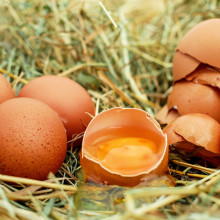
34:44 - How do chicken eggs get fertilised?
How do chicken eggs get fertilised?
Afnan Azizi, KCL and The Francis Crick Institute
"How do chicken eggs get fertilised, when there's a shell around them?", asks Amelia. Developmental biologist Afnan Azizi from KCL and The Francis Crick Institute cracks open the science of chicken development...
Afnan - The egg shell is made up of calcium carbonate or calcite, the same stuff that limestone and marble are made of. The whole function of the egg shell is to protect the developing embryo of the chicken from danger, especially from bacteria and parasites. So, a rooster’s sperm definitely can’t get through the shell to fertilize the egg. But it can before the shell forms. The chicken’s reproductive tract is about 75 cm long and each part of it is specialized to form the egg to the final shape that we see it. Like the female members of many other animal species, including humans, each chicken is born with all the eggs that she’ll ever lay, fertilized or not.
Just to clarify when we say an egg “cell”, in biology, we mean the cell that is contributed by the mother and fuses to the sperm to create a zygote. And the zygote is the very first cell that has the genetic information from the mom and the dad. It then divides many, many times to make a new animal. So, in a chicken’s ovaries, at any given time, egg cells and yolks.
And the yolk is a food storage system because if the egg cells fertilise, the mother hen can’t actually feed the growing embryo like human mothers can. So at each reproductive cycle, the most mature yolk with its attached egg cell is dropped into a specialized pouch called the infundibulum (rather a mouthful!) where it stays for up to half an hour. This is the only chance a sperm will get to fertilize the egg.
So if a rooster has mated with a chicken and its sperm has managed to swim the approximately 70 cm distance to combine with the egg cell, then you could get a fertilized chicken egg. After this, the rest of the process is the same for fertilized and unfertilized eggs. The yolk is covered by a layer of albumen, or egg white, and that is all wrapped in a couple of really thin membranes. The outer one has a network of regularly spaced protein fibers where the calcium carbonate crystalises in a process called calcification. A process that is very similar to what happens in bone development, but is much faster when making the egg shell. The chicken gets the calcium from its rib and leg bones (that have to then be replaced by calcium from food) and the carbonate from the carbon dioxide it would normally breathe out. The whole process takes about 26 hours and half an hour after a chicken lays an egg, the process can start again. Interesting fact: chickens can store a rooster’s sperms for up to two weeks and fertilize multiple eggs after mating only once.
Now it's good to know that majority of eggs we get from supermarkets and grocery stores aren’t fertilised because the farmers limit mating of egg laying chickens. But even if the egg were fertilized, we need an optimal temperature of 37 degrees Celsius to grow. And anything below room temperature would completely stop its development. So it's very unlikely to get a fertilised egg from most commercial sources. And even if one does make it to your kitchen, it's very unlikely to develop unless you put it in an incubator.
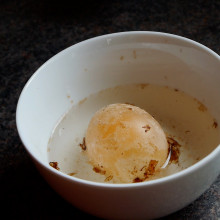
39:08 - Dissolving an egg shell
Dissolving an egg shell
Dave Ansell, Sciansell; Adam Murphy
Dave Ansell and Adam Murphy celebrate Easter with this egg-cellent egg experiment...
Dave - For this demo you need an egg, some vinegar, ideally malt vinegar - something really quite strong - and a jar with a lid on it.
Adam - I've got my egg, I've got my vinegar and I've got a jar. So Dave, how do we go about putting together this eggs-periment?
Dave - Very good. First of all, you want to take some vinegar and pour it into the jar. I happen to have a gallon of vinegar here for some reason. So I'll pour this in.
Adam - I do not have a gallon, but I'll pour in what I've got.
Dave - You want enough in there so the egg is completely covered. But not so much that you're gonna get vinegar all over the table when you put an egg in it. Take your egg and lower it gently into the jar, ideally without breaking it. Then put the lid on loosely - not too tightly because you might get some gas given off in this reaction. Oo, looking at my egg now, it's covered in little tiny bubbles. These should be carbon dioxide because the egg shell is made of calcium carbonate, same stuff as limestone. And that will react with the vinegar to create a salt and carbon dioxide which is coming off as bubbles.
Adam - Is this process just like pickling eggs? Like you'd buy pickled eggs in a chip shop?
Dave - Not quite the same although it has some similar properties. Normally when you pickle something, you would cook it first, which will break down all of the cells and make it a lot easier for the vinegar to diffuse into the middle and basically fill the whole thing with vinegar, which will kill any bacteria in there, so preserve it. You also kill the bacteria by cooking it, which is useful. We're also not giving this early long enough to fully pickle it. So maybe the outside edge of the egg will end up pickled, but the middle of it won't have enough time to be pickled properly. And then leave it for a few hours or probably better overnight and we'll have a look at it then.
Katie - This is where the patience comes in. But, rest assured, Adam and Dave have plenty of time on their hands!
Adam - Right, so it has been three days roughly since I put my egg in a jar of vinegar. Unfortunately my egg has lost integrity and there's now just a fairly disgusting puddle sitting in jar. Dave, have you had any better luck than me?
Dave - My egg, it looks, it's still egg shaped. It's covered in some bubbles. I think it's probably grown a little bit bigger than it was before. I'll just pour it out of the jar into a bowl. And it doesn't have a shell on it at all. It's kind of slightly squishy. It was a brown egg with a sort of filmy membrane, which is floating around it. And if I hold it up to the light, you can just, it's sort of a translucent ball, you can just about see where the yolk is floating around inside.
Adam - When you say it's grown a bit, what do you mean by that?
Dave - Now, instead of being covered by a hard shell, the hard shell has dissolved in the vinegar. It's just covered in that kind of membrane, which you get just underneath the shell of an egg. And that's kind of rubbery. And so I think what's happened is that osmosis - there's a process called osmosis, which means liquid will tend to go from less concentrated areas to more concentrated areas, so water's moved into the egg and it swelled up slightly. So it feels taught inside. It's very, very rigid, like a full balloon. Yeah. Basically it feels like a balloon full of egg.
Adam - So what's actually happened to it? Why is it turned from an egg to a balloon full of egg?
Dave - The balloon was always inside the egg. It's that membrane which you find if you're eating a boiled egg, and it tends to stick inside the shell, but the vinegar has just dissolved away the hard shell leaving that membrane and it swelled up a bit, do to osmosis.
Adam - And then do you have any ideas about why yours worked so well and mine disintegrated?
Dave - Did you use a very cheap egg Adam?
Adam - It wasn't, it wasn't top shelf, let's put it that way.
Dave - My guess is that whereas mine was actually quite a good quality free range egg. My guess is that large healthy chickens will probably have more resources to spare to make a nice big strong membrane around the outside of their eggs. Whereas slightly unhealthy battery chickens probably put less effort into it. And so the eggs are less robust. It's definitely true of the thickness of the shell, so I don't see why it wouldn't be true of the membrane as well.
Adam - Would you be willing to eat this egg?
Dave - There's no fundamental reason not to. I imagine it will taste very strongly of vinegar, but I'd want to cook it first.
Adam - Yeah. I think I'd want to do that. I think otherwise it would be a hard no from me.
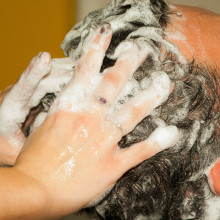
44:16 - Shampoo chemistry
Shampoo chemistry
Ljiljana Fruk, Cambridge University
"Why do normal shampoos sting my eyes, but baby shampoos don't?" This is what listener Donald wanted to know, so we asked Cambridge University chemist Ljiljana Fruk...
Ljiljana - Before I answer this question, let’s look at the eyes first (ha, pun intended). To make sure we can focus well on the images around us, the surface of the eye needs to be smooth. Any imperfections or surface debris would interfere with this, possibly blurring vision. So to maintain a healthy eye surface, our tear glands produce a complex mix of water, salts, enzymes and other components to create a tear film which is constantly maintained by us blinking to protect the eye and provide soluble nutrients for the cells to thrive.
Embedded within the cornea are sensitive nerves, that can detect slight changes in the environment and make the eye blink or tear up to remove dust, or bacteria and viruses. These nerves are particularly sensitive to changes in pH: noticing if the liquid became more acidic or basic. The optimal pH of the eye is around 7, we say it is neutral.
Now….an ordinary shampoo is usually slightly acidic to be able to remove the dirt without damaging the proteins within the hair, which are sensitive to more alkaline conditions. And…( I am looking at my shampoo at the moment) they contain surfactants: these are molecules composed of two distinct chemical parts; one is attracted to water and the other one to oil. Basically, a surfactant acts as bridges between two liquids that are not mixing, and reduces surface tension, which allows a shampoo to spread nicely over a larger area and also produce a good foam. A commonly used surfactant is sodium lauryl sulfate, obtained from palm oil, which can cause an eye irritation, because surfactants can disrupt our cell membranes a little bit, and can cause a slight unfolding of our proteins, which we can experience as stinging or pain.
‘No tear’® and other baby shampoos contain different surfactants so you might notice that they do not foam that much, and are formulated to have a pH closer to 7. That also means they do not clean the hair as well as an ordinary shampoo. Funnily, urban legends claimed that baby shampoos contain desensitising medication, which numbs the eyes… which is absolutely not true. Ideally any surfactants should be kept away from the eyes. They should all be labelled as "keep away from eyes" and to rinse eyes thoroughly with clean water if this occurs.
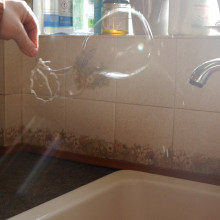
Blowing bubbles
Dave Ansell, Sciansell; Adam Murphy
Dave Ansell and Adam Murphy have fun making bubbles in this kitchen science experiment... and there's a bit of science involved too!
Dave - You want some bubble mixture. If you've got some in a pot which is made commercially, that will work fine. You can also just use washing up liquid and water. It will work better, if you live in a hard water area like most of East Anglia where we are here, either if you use de-ionised water like you'd put into a battery for a car or even just using some natural spring water from somewhere in Scotland with nice soft water. And adding a little glycerin as well will make the bubbles last longer. You also want something to make bubble formers with, so maybe some wire or some pipe cleaners. If you're using wire, you also want some string to wrap around it. Basically you're making your own pipe cleaners.
Adam - I didn't have any commercial bubble mixture so I've gotten a little bit of water and I put in quite a lot of washing up liquid into that. And in terms of former, I've just got a coat hanger that I folded into a few loops
Dave - That'll work! For complicated reasons, I have a gallon of bubble mixture which was in my shed, so I'm going to use that. And I've got some wire with some string wrapped around it to make formers. I'm gonna pour my bubble mixture into a jug, which is making it really nice and bubbly and now we can make some bubbles.
Adam - Yeah, this one is just fun. I've been standing here blowing bubbles.
Dave - Oh, that's a pretty nice bubble!
Adam - So I've got kind of a little loop here and I found that it's not good at blowing big bubbles, but what it will do is blow a load of smaller ones, which is fun.
Dave - I've got a pear shaped loop of wire string wrapped around it. The string basically just holds the bubble mixture and stops the film growing out. And it's about 6 centimeters long and three centimeters wide. If I blow up with it, they're coming out at maybe seven or eight centimeters across. I was impressed. It turns out that this double mixture is pretty good.... That one was almost about 15 centimeters!
Katie - Okay. Okay. Stop showing off. Where's the science in all of this?
Dave - Something to notice is that although the loop which you're blowing with probably isn't a circle, all the bubbles very quickly turn into a ball shape, a sphere. So this film, although it reduces the surface tension of water. (Surface tension is basically - the surface of water, doesn't like being a surface. It tries to get as small as possible. So although the detergent reduces this surface tension, it doesn't take it away entirely. And you can show this if you happen to make a former and you get an extra piece of string down the middle, and you pull it out so there's a film on both sides of the piece of string. If you pop the bubble on one side of the string, the string is pulled across in the other direction because the film is trying to shrink and get as small as it possibly can. And the shape for a certain volume, which has the smallest possible surface area, is a sphere. So bubbles always try and form spheres unless you get more than one bubble touching, when you can get other interesting effects.
Adam - And it is also fun as well. So Dave, if the bubbles are more stable and they pull themselves into spheres, why do they just pop in the air after a while?
Dave - Yeah. As soon as there's a hole in the bubble, it will pop because it's trying to shrink as quickly as possible. I mean, just like a balloon and any hole we'll make it pop. Now there's various ways of making holes. The traditional one is that you poke it with your finger and it goes pop, or it hits the floor and that makes it break, and the rest of the bubble collapses. But in ideal conditions, the two things that should cause it to fail, one is the water. It slowly evaporates and you eventually end up with no water in some part of the film, and then it will go pop. The other effect is that there is a little gap between the two layers of detergent in the film and the water will tend to flow down this gap. In fact, if you get a fresh film hold it up to the light, you can kind of see the little runnels of liquid flowing down through it, as the water drains out of the film. And in a bubble, eventually all the water would drain from the top. You'll end up with no liquid at the top. At which point you'll get a hole, at which point it pops. And this is why you add things like glycerin to bubble mixture, which will make the water more viscous and slow down the rate at which it's slowing down through the film. And so the bubble will last longer.
They actually add it (glycerin) to washing up liquid to make the foams last longer. Apparently they do the same thing with European clothes washing powder, but not with American clothes washing powder. Everyone in Europe has washing machines which you can see into the inside of. So you want to be able to see the bubbles. If it's not making bubbles and everyone thinks their washing powder isn't working, but it doesn't actually help clean clothes, having bubbles. Detergent does, but bubbles don't. And in the States, no one has washing machines which you can see inside of. So no one expects to see bubbles. So they don't make any.
Adam - If you're stuck inside as well, this is a fun way to entertain all the kids. I mean, I'm a 31 year old kid and it's entertaining me.






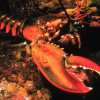

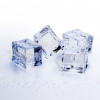

Comments
Add a comment